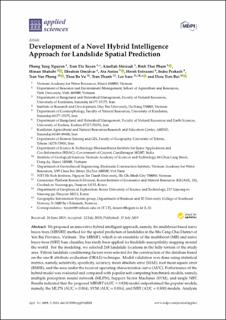Development of a Novel Hybrid Intelligence Approach for Landslide Spatial Prediction
| dc.contributor.author | Nguyen, Phong Tung | |
| dc.contributor.author | Tuyen, Tran Thi | |
| dc.contributor.author | Shirzadi, Ataollah | |
| dc.contributor.author | Pham, Binh Thai | |
| dc.contributor.author | Shahabi, Himan | |
| dc.contributor.author | Omidvar, Ebrahim | |
| dc.contributor.author | Amini, Ata | |
| dc.contributor.author | Entezami, Heresh | |
| dc.contributor.author | Prakash, Indra | |
| dc.contributor.author | Phong, Tran Van | |
| dc.contributor.author | Vu, Thao Ba | |
| dc.contributor.author | Thanh, Tran | |
| dc.contributor.author | Saro, Lee | |
| dc.contributor.author | Tien Bui, Dieu | |
| dc.date.accessioned | 2020-03-16T13:21:58Z | |
| dc.date.available | 2020-03-16T13:21:58Z | |
| dc.date.created | 2019-07-19T13:38:26Z | |
| dc.date.issued | 2019 | |
| dc.identifier.citation | Applied Sciences. 2019, 9 (14), . | en_US |
| dc.identifier.issn | 2076-3417 | |
| dc.identifier.uri | https://hdl.handle.net/11250/2647008 | |
| dc.description | Licensee MDPI, Basel, Switzerland. This article is an open access article distributed under the terms and conditions of the Creative Commons Attribution (CC BY) license | en_US |
| dc.description.abstract | We proposed an innovative hybrid intelligent approach, namely, the multiboost based naïve bayes trees (MBNBT) method for the spatial prediction of landslides in the Mu Cang Chai District of Yen Bai Province, Vietnam. The MBNBT, which is an ensemble of the multiboost (MB) and naïve bayes trees (NBT) base classifier, has rarely been applied for landslide susceptibility mapping around the world. For the modeling, we selected 248 landslide locations in the hilly terrain of the study area. Fifteen landslide conditioning factors were selected for the construction of the database based on the one-R attribute evaluation (ORAE) technique. Model validation was done using statistical metrics, namely, sensitivity, specificity, accuracy, mean absolute error (MAE), root mean square error (RMSE), and the area under the receiver operating characteristics curve (AUC). Performance of the hybrid model was evaluated and compared with popular soft computing benchmark models, namely, multiple perceptron neural network (MLPN), Support Vector Machines (SVM), and single NBT. Results indicated that the proposed MBNBT (AUC = 0.824) model outperformed the popular models, namely, the MLPN (AUC = 0.804), SVM (AUC = 0.804), and NBT (AUC = 0.800) models. Analysis of the model results also suggested that the MB meta classifier ensemble model could enhance the prediction power of the NBT model. Therefore, the MBNBT is a suitable method for the assessment of landslide susceptibility in landslide prone areas. | en_US |
| dc.language.iso | eng | en_US |
| dc.rights | Navngivelse 4.0 Internasjonal | * |
| dc.rights.uri | http://creativecommons.org/licenses/by/4.0/deed.no | * |
| dc.title | Development of a Novel Hybrid Intelligence Approach for Landslide Spatial Prediction | en_US |
| dc.type | Peer reviewed | en_US |
| dc.type | Journal article | en_US |
| dc.description.version | publishedVersion | en_US |
| dc.rights.holder | © 2019 by the authors. | en_US |
| dc.source.pagenumber | 24 | en_US |
| dc.source.volume | 9 | en_US |
| dc.source.journal | Applied Sciences | en_US |
| dc.source.issue | 14 | en_US |
| dc.identifier.doi | 10.3390/app9142824 | |
| dc.identifier.cristin | 1712130 | |
| cristin.ispublished | true | |
| cristin.fulltext | original | |
| cristin.qualitycode | 1 |
Files in this item
This item appears in the following Collection(s)
-
Institutt for økonomi og it [152]
-
Publikasjoner fra CRIStin [3401]

